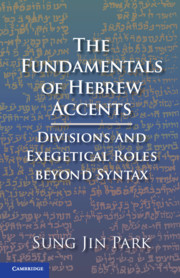Book contents
- The Fundamentals of Hebrew Accents
- The Fundamentals of Hebrew Accents
- Copyright page
- Dedication
- Contents
- Tables
- Preface
- Abbreviations
- 1 Introduction to Tiberian Hebrew Accents
- 2 Major Rules of Hebrew Accents
- 3 Substitutions of Disjunctive Accents (I)
- 4 Substitutions of Disjunctive Accents (II)
- 5 Conjunctive Accents
- 6 Minor Rules of Hebrew Accents
- 7 The Divisions by Hebrew Accents
- 8 The Exegetical Roles of the Divisions
- Book part
- Bibliography
- Subject Index
- Scripture Index
4 - Substitutions of Disjunctive Accents (II)
Published online by Cambridge University Press: 27 June 2020
- The Fundamentals of Hebrew Accents
- The Fundamentals of Hebrew Accents
- Copyright page
- Dedication
- Contents
- Tables
- Preface
- Abbreviations
- 1 Introduction to Tiberian Hebrew Accents
- 2 Major Rules of Hebrew Accents
- 3 Substitutions of Disjunctive Accents (I)
- 4 Substitutions of Disjunctive Accents (II)
- 5 Conjunctive Accents
- 6 Minor Rules of Hebrew Accents
- 7 The Divisions by Hebrew Accents
- 8 The Exegetical Roles of the Divisions
- Book part
- Bibliography
- Subject Index
- Scripture Index
Summary
Chapter Four continues to investigate substitutions of disjunctive accents and conditions under which these substitutions occur at the D2 and D3 levels. At the D2 level, the disjunctive accent at the D2 level is Rebia, and there are three final disjunctive accents of this level (D2f): Pashta (before Little Zaqeph), Zarqa (before Segolta) and Tebir (before Tiphcha). All these accents govern Geresh as the near subordinate segment and Pazer or Great Telisha, Pazer’s substitute, as the remote subordinate segment. There are three substitutions in this level: substitution of Yethib for Pashta, substitution of Pashta for Rebia, and substitution of Zarqa or Tebir for Rebia. At the D3 level, The disjunctive accent at the D3 level is Pazer, and the final disjunctive accents of this level (D3f) is Geresh. In this level, there are three substitutions and one interchange: substitution of Garshaim for Geresh, interchange of Great Telisha with Geresh, substitution of Great Telisha for Pazer, and substitution of Great Pazer for Pazer.
Keywords
- Type
- Chapter
- Information
- The Fundamentals of Hebrew AccentsDivisions and Exegetical Roles beyond Syntax, pp. 35 - 52Publisher: Cambridge University PressPrint publication year: 2020



